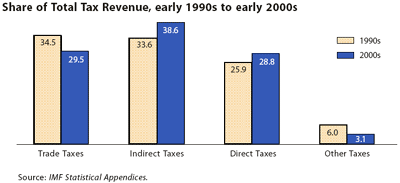
|
IPC One Pager #39 called for greater ambition in raising domestic revenue for MDG strategies in low-income countries in sub-Saharan Africa. It advocated boosting revenue by four percentage points of GDP by 2015. This One Pager examines why tax reforms achieved less than half this increase in these countries between the early 1990s and early 2000s.
A major reason: ‘optimal’ tax theory is apparently not optimal in lowincome countries. An additional reason: the naпve assumption that lower rates on direct taxes could broaden their tax base. A third reason: the misguided belief that the VAT could replace trade taxes.
Our results suggest: 1) trade liberalisation limited the potential for increases in trade taxes—despite a marked rise in imports 2) lowering rates on direct taxes weakened vertical equity and had only a modest effect on broadening the tax base—despite economic recovery of the formal sector and 3) the VAT did expand tax revenue but not as grandiosely as advertised and not as an effective substitute for trade taxes.
Our results are based on a sample of 25 low-income African countries that have the disaggregated data needed for our analysis. Tax revenue increased in them from a low level of 11.6 per cent of GDP to only 13.2 per cent, a gain of a mere 1.6 percentage points in roughly ten years—well below the target of four percentage points.2
Trade taxes declined slightly as a per cent of GDP, i.e., from 4.0 per cent to 3.9 per cent. Direct taxes increased only about one quarter, namely, from 3.0 per cent to 3.8 per cent. Indirect taxes experienced the greatest increase, i.e., about 30 per cent, from 3.9 per cent to 5.1 per cent. The residual category, ‘other taxes’ (e.g., stamp duties, mining permits, airport duties), declined from 0.7 per cent to 0.4 per cent.
Consequently, as a share of total tax revenue, trade taxes dropped about five percentage points to a little below 30 per cent while indirect domestic taxes rose five percentage points to close to 39 per cent (see Figure). The modest three-percentage point rise in direct taxes (to about 29 per cent) was counter-balanced by a
corresponding drop in ‘other taxes’.
What happened to the two main components of direct taxes, personal income taxes and corporate profit taxes? A smaller sample of 18 countries that have relevant data shows that while personal income taxes accounted for two-thirds of the total increase in direct taxes, corporate profit taxes accounted for only one third.
The remaining 10-11 per cent of total direct taxes, which include property taxes, did not change.
In order to compare the VAT and non-VAT components of indirect domestic taxes, we had to reduce our sample to the 10 countries in which the VAT was introduced between the early 1990s and the early 2000s. In these, the VAT rose to 3.7 per cent of GDP while non-VAT taxes dropped from 4.2 per cent to 2.1 per cent of GDP. This
represented a net gain of 1.6 percentage points of GDP.

Indirect domestic taxes could certainly achieve more—both for boosting revenue and enhancing equity. Reducing widespread VAT refunds and levying higher rates on luxury consumption items could help. Strengthening excise taxes on such items could also add revenue. Indirect domestic taxes should be able to contribute
at least 2.0-2.5 percentage points to the targeted increase of four percentage points in tax revenue by 2015.
Direct taxes should be able to contribute at least another 1-1.5 percentage points, and more equity to the tax structure. But this would require ending tax holidays and exemptions for the corporate sector and halting the precipitous slide in its tax rates. The same logic applies to recent tax relief on personal income
for the rich. Undertaking a minimally credible effort to enlarge property taxes, particularly on urban real estate, could also help.
Further tariff reductions in sub-Saharan Africa are not advisable until domestic indirect and direct taxes substantially boost total revenue. Recent increases in imports should be able to modestly increase tariff revenue, at least by 0.5 per cent of GDP.
Recent reforms, based on ‘optimal tax theory’, have weakened precisely the taxes (on imports and corporate profits) that are easiest to collect. Had trade liberalization been more extensive, as elsewhere in the developing world, tariff revenue would have fallen much further in sub-Saharan Africa. So why in low-income countries do we insist on making the mobilization of tax revenue—already a major challenge—even more difficult for national policymakers?
Footnotes:
-
Many thanks to Magali Solimano for invaluable research assistance on this One Pager.
-
Our aggregate results in this One Pager differ slightly from those in One Pager 39 because we had to drop one country, included additional data for others and took an average of three-years as our end-points.
|
|






